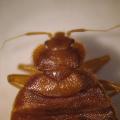 Just the idea of bed bugs makes folks squirm…which is understandable, but here in Arizona we have scarier bugs like Rhipicephalus sanguineus or Culex quinquefasciatus that actually transmit diseases like Rocky Mountain spotted fever and West Nile virus. Bed bugs don’t transmit disease but they can cause skin reactions and psychosocial stress (e.g., anxiety and sleeplessness).
Just the idea of bed bugs makes folks squirm…which is understandable, but here in Arizona we have scarier bugs like Rhipicephalus sanguineus or Culex quinquefasciatus that actually transmit diseases like Rocky Mountain spotted fever and West Nile virus. Bed bugs don’t transmit disease but they can cause skin reactions and psychosocial stress (e.g., anxiety and sleeplessness).
Bed bugs feed on human blood, and can cause itchy skin welts. If people scratch their welts with dirty hands, it’s possible they can get a skin infection, but bed bugs themselves don’t spread disease. Bed bugs like to hide in small dark places close to humans or animals (think mattress seams, stuffed animals, and piles of dirty clothes). They typically live within a meter of where people sleep and they shed their exoskeleton routinely, so you might suspect a problem if you see bed bug shells or rusty-colored blood spots around your sleeping area.
Aristotle and ancient historians tried desperately, but unsuccessfully to eradicate bed bugs from their homes by spreading dust, hanging a dead rabbit at the foot of the bed, and placing legs of the bed in pans of water. Modern attempts seem equally scattered, we’ve tried using natural predators, insecticides, and even room heaters. The current standard is to employ integrated pest management – a combined approach of chemicals and common sense practices to eliminate bedbugs from the home.
The best intervention is really prevention. Bed bugs usually hitchhike into your home (they can’t fly)…so watch what you bring inside. Leave the “free” curbside couch on the street, carefully inspect consignment store purchases, spread your own sheets when other children sleep over, and leave your luggage outside for a few nights after returning from a trip. If you see or suspect a bed bug, act immediately. If not, you might be tempted to add dust, rabbits and pans of water to your extermination plan!










Great post. This article is really very informative and effective. I think its must be helpful for our health. Thanks for sharing your nice post about A Most Unwelcome Nuisance .
disable people
famous disabled people
Dear author, I thank you for this article! Text was very helpful
What happens it you live in apartment and they do not want to send a extermination service. or they send a unlicensed one? What state agency will force them to do anything about the problem.
“Leave the “free” curbside couch on the street”
Prevention really is the best method. It’s all about using common sense to limit the addition of new bugs to your home.
prevention is the best move, before we are completely exposed to the dangers of bed bugs is. Therefore, it is important for us to always clean up every corner of the room discipline 🙂
Hello there, You have done a great job. I’ll definitely digg it
and personally recommend to my friends. I am confident they will
be benefited from this site.